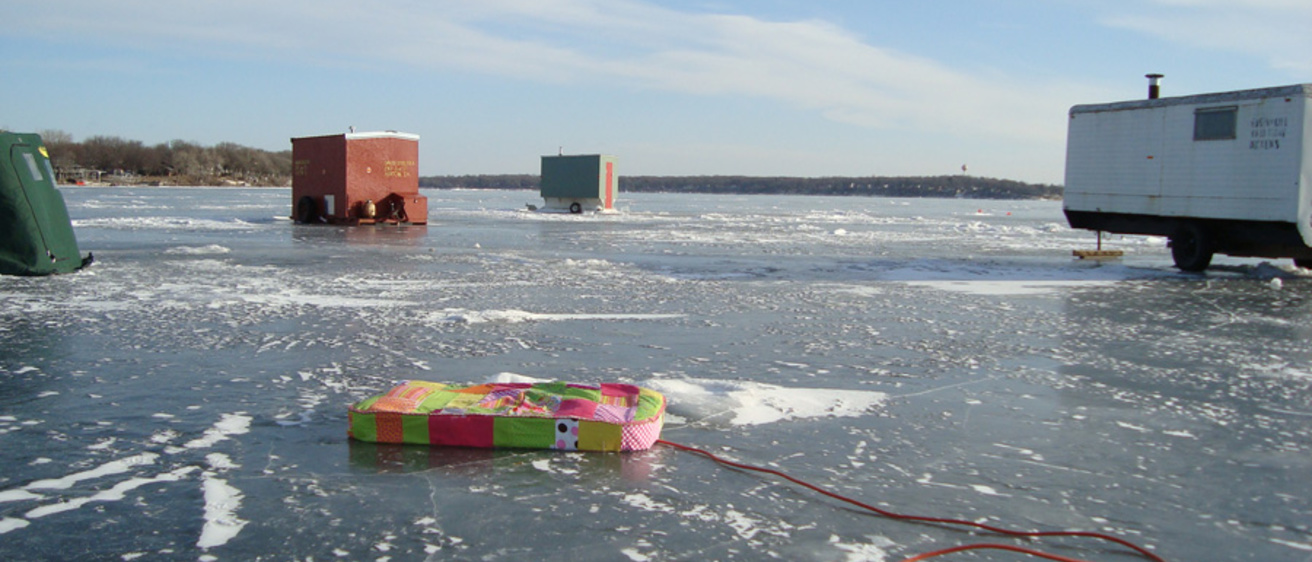In January 2012, Lisa Johnson participated in the Obermann Graduate Institute on Engagement and the Academy. Her final project was a collaborative arts ensemble between women at the Iowa Correctional Institute for Women and community partners. During the intense week-long Institute working with the public was front and center in Johnson’s mind, but having coffee with farmers near Estherville or listening to scientists talk about algae was not. And while creating art on a frozen lake may have intrigued the artist whose work ranges from set design to papermaking, and from environmental installations to playwriting, it definitely was not on her horizon.
A UI Center for the Book open house changed that. Johnson was sharing some of the paper she makes from native plant material when Steve Hendrix (Biology, CLAS), who serves as the UI’s campus coordinator for the Lakeside Laboratory, saw a possible collaboration. The field station was founded in 1909. While education is its primary function, it also serves as a nature preserve and historic district, which includes prairie restoration, woodlands, and twelve structures that are on the National Register of Historic Places.
A three-prong approach
Hendrix approached Johnson about ways to weave the arts into the Lab. What has evolved from their initial conversation is a three-prong approach that includes an arts residency program; a large-scale, community-based project; and summer arts classes that will be offered alongside the Lab’s traditional science offerings.
Johnson has been pivotal in this emerging plan for how the arts may be woven into a place best known for college-level courses on plant taxonomy, molecular ecology, and a world renown course in diatoms—an algae that is often used for monitoring environmental conditions, especially water quality. Last May, she was the first artist-in-residence at Lakeside Lab and is now organizing a call for four residencies for the coming summer.
“I wanted to do it first so that we could think through the details,” says Johnson. “It turns out, for instance, that an unheated cabin on a lake in May can be pretty cold!”
Listening to locals
Johnson, who has had previous residencies in Vermont, the Czech Republic, and Greece, credits the Graduate Institute with the approach she’s taking with Lakeside. “I’ve used language of community and collaboration from the start,” she says. For example, one requisite of the artist-in-residence program is that artists commit one day of their time in residence to engaging with the community.
Similarly, Johnson says one of the most important skills she’s brought to the project so far is one that was emphasized in the Graduate Institute: listening. Since last spring, she’s been spending time in the communities surrounding the Labs, holding open houses with local businesses, arts centers, and non-profits.
“I’m asking people what they would like a large-scale art project to entail; what would benefit them” says Johnson, who completed her MFA in sculpture in May 2012. She’s found enthusiasm, as well as some recurring themes and concerns, such as water quality and industrial farming. But people are less sure what a community-based art project might look like.
“I am hoping that everyone involved, from the scientists at the Lab to area farmers, artists, and coffee shop owners can view this as a project that we plan together from start to finish,” says Johnson.
Art touches people in a visceral way
Hendrix views Johnson’s involvement – as well as that of the incoming artists-in-residence – as invigorating the Lab’s work. As a Regents Resource Center, Lakeside Lab offers programs in lifelong learning for the people of northwest Iowa. Artists can serve as a bridge between the community and the more arcane world of the scientists whose work Hendrix says is often not well understood by the general public; “One way to communicate our work is through the arts which often touches people in a visceral way, very different from the academic lectures by scientists.”
Similarly, the scientists’ tendency toward specialization is playfully prodded by the presence of artists. “The kinds of programs Lisa is working with us to create help break down the walls between groups that result from ever increasing specialization and will, hopefully, return us to Renaissance-like times when scientists were artists and artists were scientists.”
For her part, Johnson is delighted to sit at breakfast in the summer as the scientists talk in a language that was initially foreign to her but which she’s slowly learning. “Listening to them talk about cyanobacteria and coliforms grounds the work very differently than if I were just working in a natural area but without being immersed in the community.”
Johnson is continuing to work on the original project she honed as part of the Graduate Institute. The Eva Luna Project (link no longer active) uses literature to jump-start personal story telling by incarcerated women. These stories are then woven into performances that are given both inside and outside prison in an effort to bridge community and prison relationships. Alongside that work, Johnson is now arranging burdock leaves on the paths that botanists and biologists walk in July, and creating fantastical mattresses on the frozen expanse of Lake Okoboji. And listening.
